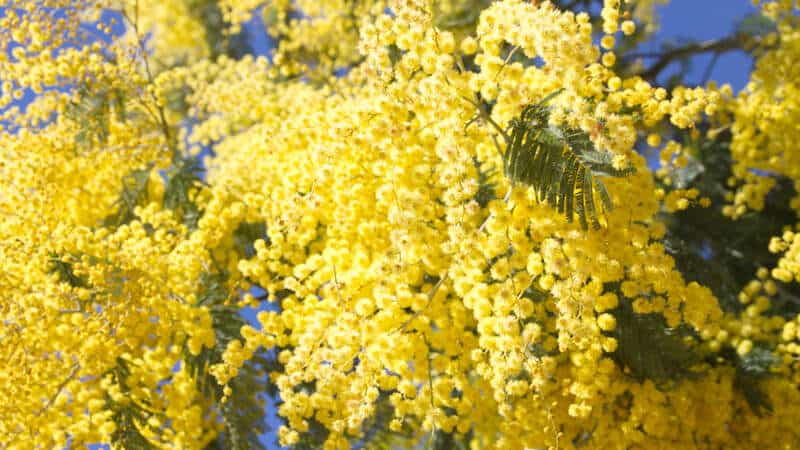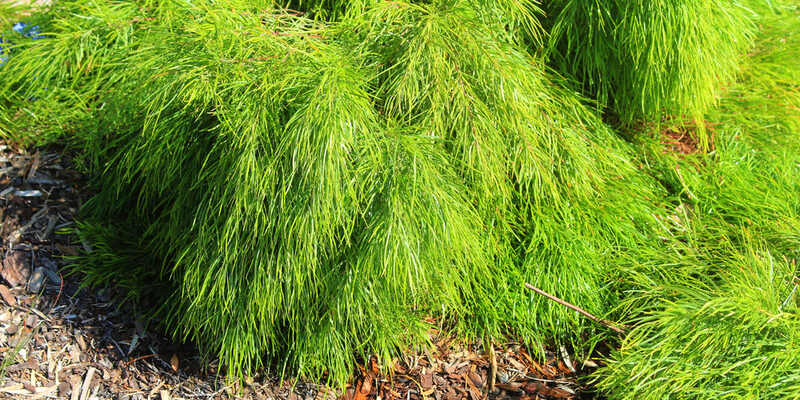The fluffy, bright yellow blooms of the wattle (acacia) are a familiar herald of late winter going into the start of spring. It’s one of the most famous of Australia’s native plants — the golden wattle (acacia pycnantha) is Australia’s national floral emblem. There’s a wide range of wattle species, but the golden wattle in particular is native to South Australia.
They can be seen in parks and along roads, but you can also have your own wattle acacia in your garden! It’s very low-maintenance, grows quickly, and flowers beautifully (so sorry to everyone with hay fever — this acacia tree is probably not for you!). As for how to grow wattle trees, it’s fairly straightforward. So wattle you waiting for? Get in touch with your local nursery and get growing!
Before Planting
Before you get some seeds or seedlings, though, make sure you check with your local council and a professional gardener for what kinds of wattle you can plant in your garden. While they are native to Australia, some species may be considered invasive or weeds, or may not be ideal for your climate.
Some wattles that can be planted in specific states include:
- New South Wales: Cootamundra wattle, Pilliga wattle, West Wyalong wattle, Gold Dust wattle
- Victoria: Box-leaf wattle, Wallowa, Sydney golden wattle
- Queensland: Queensland silver wattle, Weeping myall, Wallangarra wattle
- South Australia: Flinders Ranges wattle, Barrier Range wattle, Thorn wattle
- Western Australia: Acacia alata, Mulga, Acacia craspedocarpa, Myrtle wattle
- Australian Capital Territory: Box-leaf wattle, oven wattle
- Northern Territory: Acacia argyraea, Witchetty bush, Elephant Ear Wattle
Also check with your local nursery for what wattles they have available. Then you can grow ahead (ahem) and get started.
About Wattles
Wattles have a reputation for being fast growing, but short lived. They establish themselves rapidly from seed, and start producing their signature yellow flowers while young. Wattles only live between 7 and 12 years, but you can take advantage of their fast growing by using them as shade or screen plants! They’re also pioneer plants, which means they’re hardy and can even grow on disturbed or freshly-cleared soil.
Plant Environment
Acacia pycnantha isn’t too fussy about its planting conditions, but here’s a quick rundown of the best conditions to grow wattles.
Location
Wattles thrive in places that are anywhere from sunny to semi-shaded. They’ll tolerate extreme weather well, but may need a watchful eye if your area has heavy winter frost. Tropical climates work well for wattle plants.
In terms of co-planting, they’re ideal for placement between slow growing plants or Australian native plants that enjoy shade, or by a fence or hedge as a screen.
Soil
Wattles don’t need any particular soil type, but it’s important to have good drainage. Best to avoid low spots in your garden where water might collect, or where water moves sluggishly.
Mulch and Fertiliser
There’s no need to fertilise since wattles are capable of returning nitrogen to the ground, but you can feed them with a low-phosphorus native plant food to give them a little boost.
As for mulching, you can layer organic matter like leaf litter or bark over the ground to cool the roots and conserve moisture. It’ll also help deter weed growth and pests. But make sure not to mulch too close to the trunk!
Watering
While wattles are establishing themselves, water them regularly. But once they’ve grown, they can subsist on natural rainfall. During hotter months, water whenever the ground gets too dry to prevent trees from becoming dehydrated. Otherwise, thanks to their phyllodes (the ‘leaves’ of wattles), they’ll tolerate drought better than other trees or shrubs.
Pruning
Young wattle acacia will need regular pruning near the tips to keep the plant flourishing and stop it spreading too far. This is particularly important after flowering; you can deadhead your plant afterwards to maintain its health and remove seed heads. Don’t cut any new growth, though, and nothing thicker than a pencil.
Growing Wattle From Seed
There are many wattles available for your garden — from groundcover, to differently-sized shrubs, to tall trees. Choose the species most suitable for your state and local climate.
Because they grow fast, they’re best started from seeds or seedlings. If you’re starting them in pots, don’t only keep them there until germination — they’ll have a hard time establishing a good root system later on when planted in garden soil.
- To grow wattles from seed, simply collect ripe seed pods from a wattle plant, or purchase some from your local nursery. Pods will ripen about three to six months after flowering. You can tell they’re ripe when the pods turn brown and start drying up — but don’t let them crack open!
- Pour hot water on the seeds and let them stand for half a day (ideally overnight).
- Layer damp paper towels in a covered container and scatter the seeds over them, then keep in a dark place until germination.
- Remove germinated seeds and sow in a pot (coco peat with sand is a good potting mix!) at a depth of 0.5cm.
- Water regularly and keep somewhere with plenty of light, but out of direct sun exposure.
- Once the seedling has established a root system, it’s ready for transferring.
- After transplanting into your garden, water plants regularly until you see new leaves. Then you can begin tapering off your watering, to get your wattles accustomed to subsisting off natural rainfall.
If you’re looking to grow wattles from seedlings, simply dig a hole in your garden twice as wide and just as deep as the container. Place the plant inside, then backfill with soil and maintain the same way as a seedling grown from germination.
Tend to your wattles, watch them grow, and enjoy the stunning yellow flowers every winter through spring!
Other Tips
Dwarf Wattles
There are compact varieties of wattles available for those with limited garden space, or who want to keep them indoors. They can even be planted on top of walls or among other flowering shrubs.
There’s also the ‘Mini Cog’ — a low, mounded shrub that grows about a metre high, which is actually a shrub form of the bower wattle. It can work as a hedge, as groundcover, or as a path decoration. The bright green foliage also means it makes a great accent plant.
Wattle Wildlife
Wattles tend to attract wildlife to your garden, from typical birds and butterflies, to possums, and even to kangaroos! Marsupials can eat wattle leaves (phyllodes), while birds will eat the seeds or fruits. These may attract other predators to your yard, so be careful of any unwanted guests!
Pests
Tick scale usually occurs in plants in specific parts of Australia — mostly the east, south, and west regions. It’s common to species such as black wattle, Sydney golden wattle, and hickory wattle.
They also attract moths, spittlebugs, and borers (the usual cause of wattle degradation). Galls are small bumps or growths caused by insects, but can thankfully be trimmed off.







